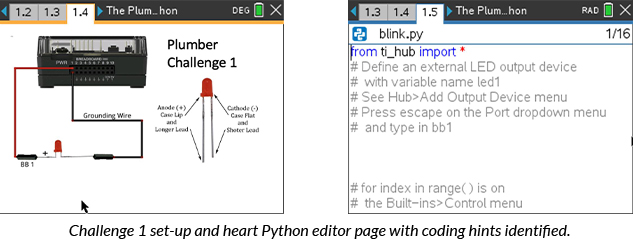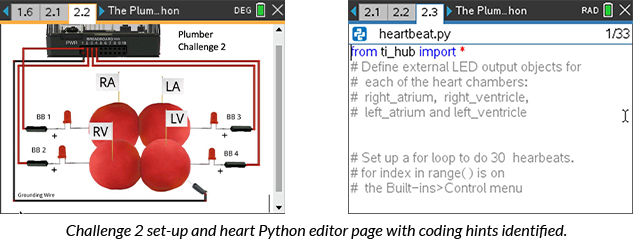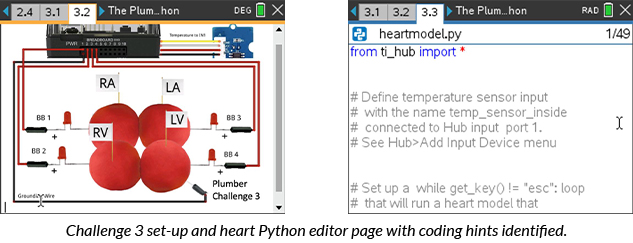The Heartbeat of STEM
Does your heart skip a beat when you think about STEM? If it doesn’t already, it will after you learn about the heart STEM project. “The Heart Project” is a great way to introduce your students to coding while teaching your students about the structure of the heart and flow of blood through the heart. And just in time for Valentine’s Day and American Heart Month!
As an Advanced Placement biology teacher, I don’t always have the time to do as much STEM integration as I like. However, when the AP® exams are over, I utilize as many of the STEM projects as possible. “The Heart Project” is a favorite of mine to go more in depth about the circulatory system, transport and homeostasis, but it also allows students to build electrical circuits and write a simple program to control the model.
Students become familiar with coding by using the easily accessible menu-based system within TI calculators. These activities are available using multiple platforms and languages: TI-Basic (TI-Nspire™ CX, TI-Nspire™ CX II or TI-84 Plus CE graphing calculators) and Python (TI-Nspire™ CX II and TI-84 Plus CE Python edition graphing calculators). The activities available at TISTEMProjects.com set up students for success by completing building skills with different challenges to help them become familiar with programming.
In “The Plumber: Modeling the Four-Chambered Heart for the TI-Nspire™ CX II Graphing Calculator” activity, students need to complete three different challenges to demonstrate the function of a heart.
In challenge 1, students set up a simple circuit using the breadboard on the TI-Innovator™ Hub and a red LED. They also need to write a program to get the LED to blink at a certain rate. To help the students that may be new to programming, comments are embedded in the Python editor page to provide support.

Challenge 2 brings in modeling of the flow of blood through the heart by writing a program to blink four LED lights in a sequence to show the flow of blood through the heart starting with the right atrium and ending with the left ventricle. Students add in sounds after each cycle to beep like an EKG machine. They can also figure out how to speed up or slow down their cycles and to calculate heart rate.

Challenge 3 is where students must put their skills to the test. This challenge models the autonomic nervous system. Students will need to write a program to show how the heart rate changes based on different external input. A Grove temperature sensor is used to modify the input, and students will need to write a program to increase the heart rate as temperature increases.

After using this activity with my AP® Biology students, I had an idea to extend it and developed an end-of-year project for my AP® students. Now that they were familiar with writing the code and setting up the heart to show both the flow of blood (LEDs) and calculating the heart rate, I wanted them to do some research on arrhythmias or when the heart does not beat as expected. The students researched the different types and causes of arrhythmia, put together a presentation, and modified their code to model how the heartbeat would change. It was a great way to end the year.
Texas Instruments’ STEM Projects give you a place to start with so many resources available to help educators with any level of experience integrating STEM activities into their classroom. For every project, there are teacher documents, student documents, completed programs, supplemental reference sheets on the programming language, and even videos to demonstrate the project. You can reach out to the STEM Team for help. If you don’t have the equipment, you can even borrow technology and kits from the STEM Team!
Don’t miss a beat and check out this STEM project.
About the author: Jessica Kohout has taught all levels of biology, from on-grade level to AP® and marine science, at Reservoir High School in Howard County, Maryland. She is a T³™ National Instructor and sees technology as a great way to help students make real-life connections with science. Follow her on Twitter and Instagram @MrsKohout.
AP® is a trademark registered by the College Board, which is not affiliated with, and does not endorse, TI products. Policies subject to change. Visit www.collegeboard.org.
Tagcloud
Archive
- 2025
- 2024
- 2023
- 2022
-
2021
- January (2)
- February (3)
- March (5)
-
April (7)
- Top Tips for Tackling the SAT® with the TI-84 Plus CE
- Monday Night Calculus With Steve Kokoska and Tom Dick
- Which TI Calculator for the SAT® and Why?
- Top Tips From a Math Teacher for Taking the Online AP® Exam
- Celebrate National Robotics Week With Supervised Teardowns
- How To Use the TI-84 Plus Family of Graphing Calculators To Succeed on the ACT®
- AP® Statistics: 6 Math Functions You Must Know for the TI-84 Plus
- May (1)
- June (3)
- July (2)
- August (5)
- September (2)
-
October (4)
- Transformation Graphing — the Families of Functions Modular Video Series to the Rescue!
- Top 3 Halloween-Themed Classroom Activities
- In Honor of National Chemistry Week, 5 “Organic” Ways to Incorporate TI Technology Into Chemistry Class
- 5 Spook-tacular Ways to Bring the Halloween “Spirits” Into Your Classroom
- November (4)
- December (1)
-
2020
- January (2)
- February (1)
- March (3)
- April (1)
- May (2)
- July (1)
- August (2)
- September (3)
-
October (7)
- Tips for Teachers in the time of COVID-19
- Top 10 Features of TI-84 Plus for Taking the ACT®
- TI Codes Contest Winners Revealed
- Best of Chemistry Activities for the Fall Semester
- Best of Biology Activities for the Fall Semester
- Best of Physics Activities for the Fall Semester
- Best of Middle Grades Science Activities
- November (1)
- December (2)
- 2019
-
2018
- January (1)
- February (5)
- March (4)
- April (5)
- May (4)
- June (4)
- July (4)
- August (4)
- September (5)
-
October (9)
- Art in Chemistry
- Which Texas Instruments (TI) Calculator for the ACT® and Why?
- Meet TI Teacher of the Month: Jessica Kohout
- Innovation in Biology
- Learning With Your Students
- A first-of-its-kind STEM strategy charts path to help educators
- #NCTMregionals Hartford 2018 Recap
- The Math Behind “Going Viral”
- Real-World Applications of Chemistry
-
November (8)
- Testing Tips: Using Calculators on Class Assessments
- Girls in STEM: A Personal Perspective
- 5 Teachers You Should Be Following on Instagram Right Now
- Meet TI Teacher of the Month: Katie England
- End-of-Marking Period Feedback Is a Two-Way Street
- #NCTMregionals Kansas City 2018 Recap
- Slope: It Shouldn’t Just Be a Formula
- Hit a high note exploring the math behind music
- December (5)
- 2017
- 2016
- 2015
